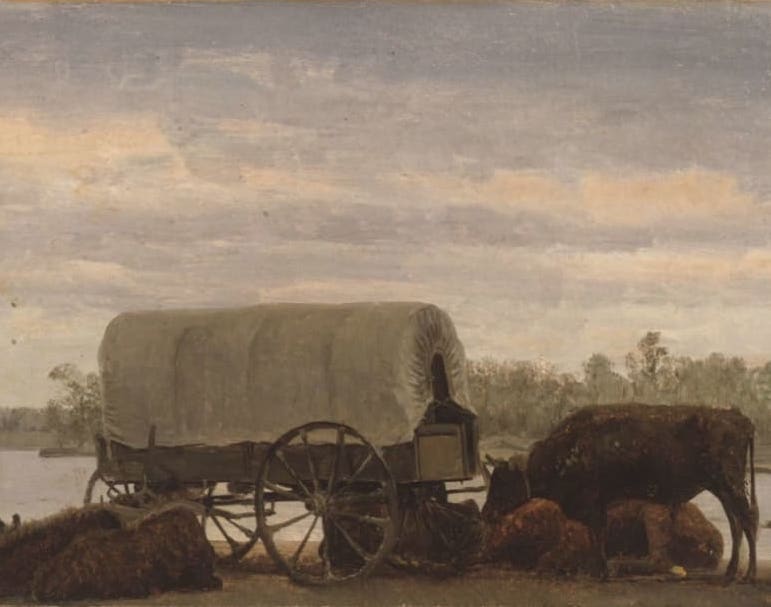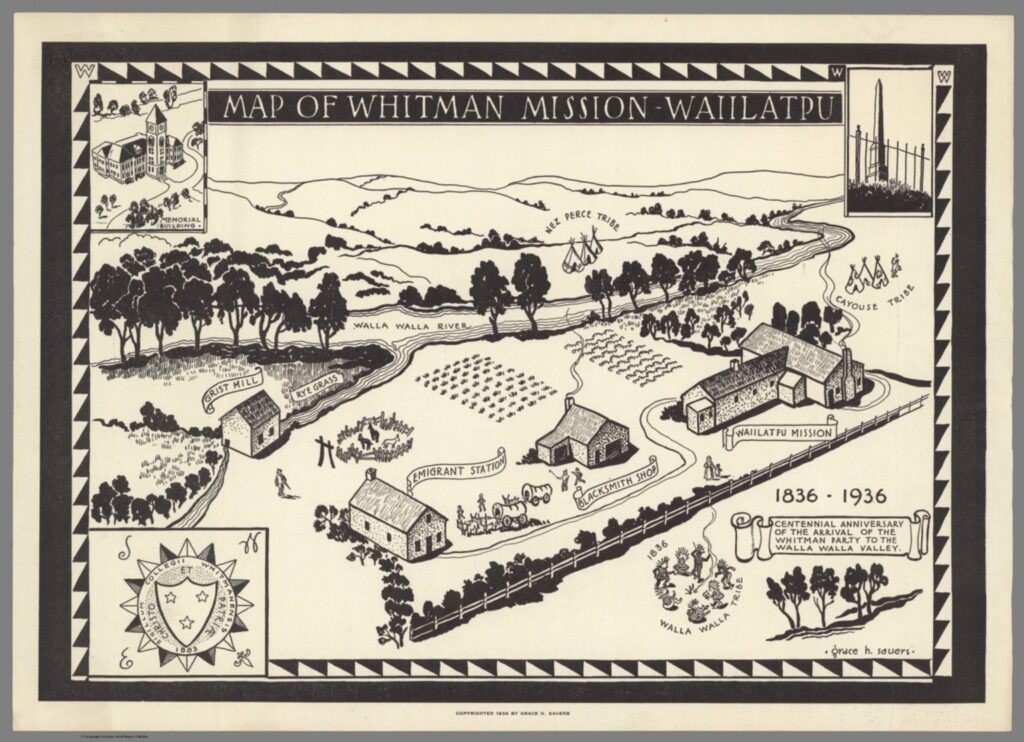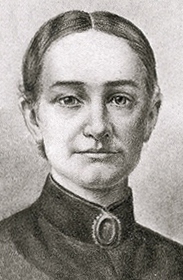
After years of inhabiting only trappers, fur traders and natives, the newly obtained Oregon Territory met its first American settlers in the 1830s, among them Narcissa Whitman and her husband Marcus, a doctor. With the intention of converting the Indigenous people, they established a mission on the lands of the Cayuse tribe, who, at first, met them with interest. The letters Whitman wrote do not only express the American self-concept, but also how she conformed to true womanhood while adjusting to her live in the western territory.
„Therefore go and make disciples of all nations, baptizing them in the name of the Father and of the Son and of the Holy Spirit, and teaching them to obey everything I have commanded you“
MATTHEW 28:19-20
Narcissa Prentiss was born in 1808 as one of nine children. She spent her whole childhood in Prattsburgh, New York. As a young adult she became enthralled with God and Christianity due to the Second Great Awakening which took place from the 1790s to the 1840s. It “marked a reemergence of religious enthusiasm, as millions of Americans were „born again“ in emotionally-charged revival meetings. […] It was in this era that the claim that the United States is a „Christian nation“ first seriously took root” (Stone 1307). Narcissa decided to become a missionary and spread the word of God. After a year of education and preparation she got married to Dr. Marcus Whitman in 1836 and only one month after their wedding they, along with another married couple, started their journey to the West on the Oregon Trail. The Whitmans wanted “to devote their lives to saving souls among the heathen” (Norton 111). Narcissa kept a journal, writing down her own experiences on their travels. They eventually settled down near Fort Walla Walla and started the Whitman Mission close to the Native American tribe of the Cayuse in 1837. Narcissa Whitman soon gave birth to her only biological daughter, who later drowned in the river at age two.

To stay in contact with her parents, her eight siblings and friends, Narcissa started writing letters. She informed them about her days, the landscape, her work, things that bothered her and so on in a very emotional and chatty way. Her letters were meant to be private, although she probably was aware that her family was showing them around. There were huge time gaps between the letters because they took months to arrive, and they were rather long to keep her family up to date with everything that happened. Her sisters donated them in 1894, where they were released for the public.
A lot of her letters give a very good insight on how Narcissa Whitman was feeling. She seemed to be quite homesick, trying to convince her family in several letters to come visit and even live with her. She also tried to recruit her sister Jane and her brother-in-law to work for the mission as teachers. Narcissa was alone a lot. Her husband whom she called her “earthly protector” (Whitman 55) was always busy and traveled a lot. Sometimes he was gone for months. Several health issues made her life in the West even harder. She was sick a lot. One time it was so severe it “threatened almost immediate death” (Whitman 56). In these times she found relieve in her beliefs. Whitman also wrote about her relationship with the Native Americans. Her parents seemed to fear them, but she assured them in one of her last letters that “they never were more quiet and peaceful than now`, and appear to be getting more so” (Whitman 87).

“Bringing up a family of children in a heathen land, where every influence tends to degrade rather than elevate, requires no small measure of faith and patience, as well as great carefulness and prayerful watchfulness”
NARCISSA WHITMAN TO HER FATHER ON APRIL 10TH, 1846
Whitman saw her purpose in “the care of so many immortal souls to train up for God” (Whitman 75)– or rather to force her Christian believes upon the Cayuse people with no regards and understanding of their culture. The territory, which they had chosen for their mission, was unsafe for growing masses of Protestant settlers. Even before the coinage of the term Manifest Destiny in the 1840s, the ideology behind it had already cultivated the minds of the young American nation. The land (re-)discovered by Americans was given to them by God, and therefore his word had to spread out from the Atlantic to the Pacific coast, or even further. The westward expansion was seen as necessary in order for the nation to thrive and went hand in hand with the work of missionary travelers.
Missions into the new territories to convert the indigenous North Americans were considered as public welfare. The eurocentric view was propagated that especially women could only live freely and safely in Christianized countries. Male and female missionaries soon set out to new territories, including Oregon. Religious work could be a liberation for single women, giving them the feeling of importance and a purpose outside home and family. The wives of missionaries, on the contrary, were still supposed to keep to their homes. They embodied western womanhood, which they expected would then transfer onto the native women and girls through their work. As educators, and “guardian[s] of American democracy” (Georgi-Findlay 239), they were set on promoting their standards.

Narcissa Whitman, too, worked as a teacher on the missionary settlement of Waiilatpu. She voiced her conviction in the necessity and success of the Whitman Mission in her letters repeatedly. However, her bible studies did not bear as much fruit as she might have wished. Therefore, she concentrated her efforts on preparing the settlement for the white homesteaders and instructing her eleven adopted children in the “great truths of Christianity” (Whitman 79). Her letters revealed her to be a hard-working and refined housewife, who would occasionally share her parenting advice with her sisters. However, her letters also express her firm believe in populating the northwest of the continent with Protestants – preferably those who did not need to be converted.
Marcus and Narcissa Whitman’s mission failed, given their lack of understanding for the Cayuse traditions. Communication failed between the two parties, because the Whitmans made little effort in learning their language and concepts of Christianity, like the Heaven and sin, did not exist the Cayuse vocabulary. The tribe saw no need in converting. Incoming settlers brought a measles epidemic over the natives, which led to the death of many tribe members. Years of injustice climaxed in November 1847, when the Cayuse murders Narcissa, her husband and twelve other people of the mission. The tribe suspected them and especially Dr. Whitman to actively let their people die of the sickness. “The murders became known as the Whitman Massacre” (Norton 108).
Source:
Whitman, Narcissa: Mrs. Whitman’s Letters 1843-1847 https://archive.org/details/mrswhitmanslette00whit/page/74/mode/2up?view=theater
Secondary Literature:
Georgi-Findlay, Brigitte: The frontiers of women’s writing: women’s narratives and the rhetoric of westward expansion.Tucson University of Arizona Press, 1996.
Heidler, Jeanne T. „Manifest Destiny.“ https://www.britannica.com/event/Manifest-Destiny
Merk, Frederick. Manifest destiny and mission in American History: a reinterpretation. New York, New York Vintage Books, 1966.
Norton, Melanie J. and Booss, John: “Missionaries, measles, and manuscripts: revisiting the Whitman tragedy.” Journal of the Medical Library Association, Vol 107, No.1, 2019, pp. 108-113.
Stone, Geoffrey R. “The Second Great Awakening: A Christian Nation.” Georgie State University Law Review, Vol. 26, No. 4, 2010, pp. 1305-1334.
Welter, Barbara. “She Hath Done What She Could: Protestant Women’s Missionary Careers in Nineteenth-Century America,” American Quarterly, Vol.30, No. 3, 1978, pp. 624-638.
Pictures:
Narcissa Whitman https://commons.wikimedia.org/wiki/File:Narcissa_Whitman.jpg
Nooning on the Platte https://www.slam.org/collection/objects/963/
Sager Family https://en.wikipedia.org/wiki/File:Sager_family.jpg
Map of the Whitman Mission Waiilatpu https://www.davidrumsey.com/luna/servlet/detail/RUMSEY~8~1~289644~90061546:Map-of-Whitman-Mission—Waiilatpu